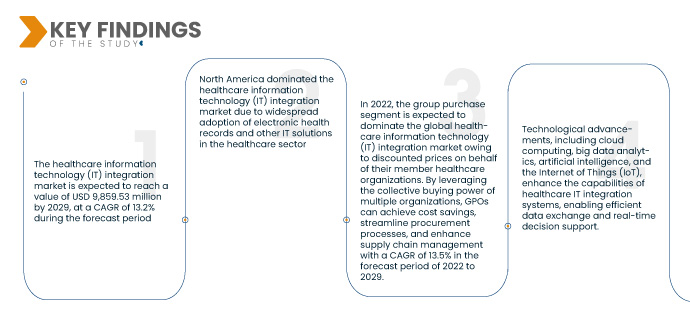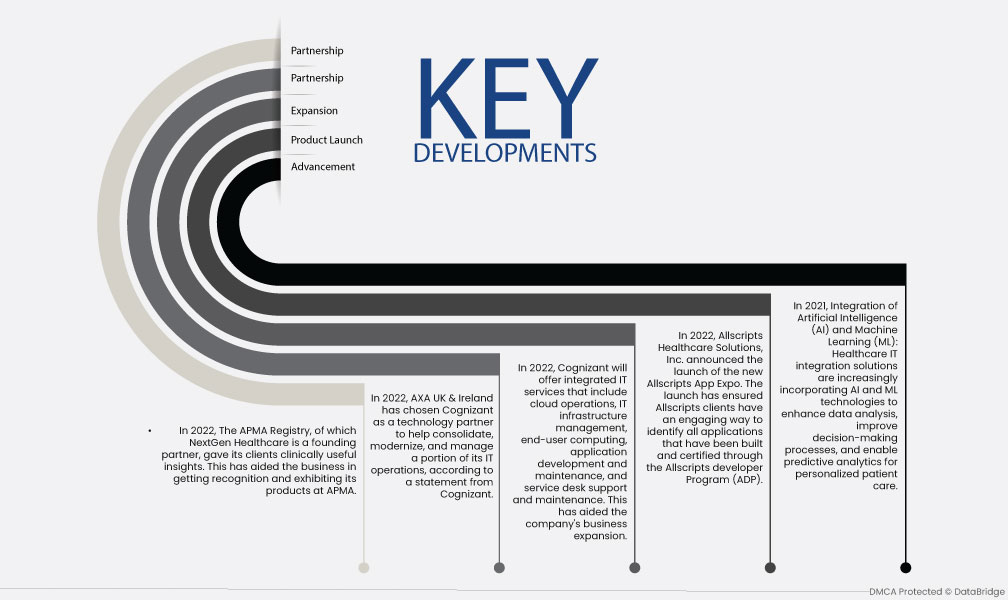Healthcare systems can collect data, exchange it with the cloud, and communicate with one another through healthcare IT integration, which enables quick and accurate data analysis. Monitoring, diagnosis, and delivery methods are just a few of the tasks that the Internet of Things (IoT) can perform by fusing sensor output with communications. The sensors may be built into a machine, accessible via the cloud, or wearable. As a result of the advancements in ICT and such sensors, the healthcare industry now has access to a dynamic database of patient data that can be used to support diagnostics, provide preventive care, and determine the likelihood that a preventive treatment will be successful.
Access Full Report @ https://www.databridgemarketresearch.com/jp/reports/global-healthcare-it-integration-market
Data Bridge Market Research analyses that the Healthcare Information Technology (IT) Integration Market is expected to reach a value of USD 9,859.53 million by 2029, at a CAGR of 13.2% during the forecast period. Healthcare IT integration facilitates the seamless exchange of patient information among various healthcare systems and providers, enabling improved care coordination, decision-making, and patient outcomes drives the market of healthcare information technology (IT) integration.
Focus on cost reduction and efficiency is expected to drive the market's growth rate
Healthcare organizations are realizing the importance of cost reduction and operational efficiency in delivering high-quality care. Implementing IT integration solutions, can streamline various processes, such as patient data management, scheduling, billing, and resource allocation. These solutions enable seamless sharing and exchange of information among different healthcare systems and departments, reducing redundancies and improving productivity. Ultimately, this leads to cost savings, improved resource utilization, and enhanced patient care outcomes.
Report Scope and Market Segmentation
|
Report Metric
|
Details
|
|
Forecast Period
|
2022 to 2029
|
|
Base Year
|
2021
|
|
Historic Years
|
2020 (Customizable to 2014-2019)
|
|
Quantitative Units
|
Revenue in USD Million, Volumes in Units, Pricing in USD
|
|
Segments Covered
|
Product and Services (Product, and Services), Application (Medical Device Integration, Internal Integration, Hospital Integration, Lab Integration, Clinics Integration, and Radiology Integration), Facility Size (Large, Medium, and Small), Purchase Mode (Group Purchase Organization, and Individual), End User (Hospitals, Laboratory, Diagnostic Centers, Radiology Centers, and Clinics).
|
|
Countries Covered
|
U.S., Canada and Mexico in North America, Germany, France, U.K., Netherlands, Switzerland, Belgium, Russia, Italy, Spain, Turkey, Rest of Europe in Europe, China, Japan, India, South Korea, Singapore, Malaysia, Australia, Thailand, Indonesia, Philippines, Rest of Asia-Pacific (APAC) in the Asia-Pacific (APAC), Saudi Arabia, U.A.E, South Africa, Egypt, Israel, Rest of Middle East and Africa (MEA) as a part of Middle East and Africa (MEA), Brazil, Argentina and Rest of South America as part of South America.
|
|
Market Players Covered
|
Lyniate (U.S.), Redox, Inc. (U.S.), CarePoint Health (U.S.), NextGen Healthcare Inc. (U.S.), Interfaceware, Inc. (Canada), Koninklijke Philips (Netherlands), Oracle (U.S.), AVI-SPL, Inc. (U.S.), Allscripts Healthcare Solutions, Inc. (U.S.), Epic Systems Corporation (U.S.), Qualcomm Life Inc. (U.S.), Capsule Technologies Inc. (U.S.), Orion Health (New Zealand), Quality Systems, Inc. (U.S.), Cerner Corporation (U.S.), InterSystems Corporation (U.S.), Infor Inc. (U.S.), GE Healthcare (U.S.), McKesson Corporation (U.S.), and Meditech (U.S.)
|
|
Data Points Covered in the Report
|
In addition to the insights on market scenarios such as market value, growth rate, segmentation, geographical coverage, and major players, the market reports curated by the Data Bridge Market Research also include depth expert analysis, patient epidemiology, pipeline analysis, pricing analysis, and regulatory framework.
|
Segment Analysis:
The healthcare information technology (IT) integration market is segmented on the basis of product and services, application, facility size, purchase mode, and end user.
- On the basis of product and services, the global healthcare information technology (IT) integration market is segmented into products and services. In 2022, the service segment is expected to dominate the global healthcare information technology (IT) integration market with a CAGR of 12.0% in the forecast period of 2022 to 2029 due to rapid demand for IT solutions and services globally.
In 2022, the service segment is expected to dominate the product and service segment of the global healthcare information technology (IT) integration market
In 2022, the service segment is expected to dominate the global healthcare information technology (IT) integration market owing to the critical role it plays in supporting the implementation, utilization, and optimization of healthcare products and technologies with a CAGR of 12.0% in the forecast period of 2022 to 2029.
- On the basis of application, the global healthcare information technology (IT) integration market is segmented into medical device integration, internal integration, hospital integration, lab integration, clinics integration, radiology integration, and other applications. The medical device integration segment is expected to dominate the global healthcare information technology (IT) integration market with a CAGR of 14.9% in the forecast period of 2022 to 2029 due to the increasing demand for telehealth services and remote patient monitoring solutions.
- On the basis of facility size, the global healthcare information technology (IT) integration market is segmented into large, medium and small. In 2022, the large segment is expected to dominate the global healthcare information technology (IT) integration market with a CAGR of 14.5% in the forecast period of 2022 to 2029 due to their extensive square footage and capacity to accommodate a significant number of people or operations. These facilities may include large manufacturing plants, warehouses, corporate headquarters, shopping malls, convention centers, or hospitals with a high number of beds and departments.
- On the basis of purchase mode, the global healthcare information technology (IT) integration market is segmented into group purchase organization and individual. In 2022, the group purchase segment is expected to dominate the global healthcare information technology (IT) integration market with a CAGR of 13.5% in the forecast period of 2022 to 2029 due to the leverage the collective purchasing power of multiple organizations to secure better pricing and terms for goods and services.
In 2022, the group purchase segment is expected to dominate the purchase mode segment of the global healthcare information technology (IT) integration market
In 2022, the group purchase segment is expected to dominate the global healthcare information technology (IT) integration market owing to discounted prices on behalf of their member healthcare organizations. Leveraging the collective buying power of multiple organizations, GPOs can achieve cost savings, streamline procurement processes, and enhance supply chain management with a CAGR of 13.5% in the forecast period of 2022 to 2029.
- On the basis of end user, the global healthcare information technology (IT) integration market is segmented into hospitals, laboratory, diagnostic centers, radiology centers, clinics and others. In 2022, the hospitals segment is expected to dominate the global healthcare information technology (IT) integration market with a CAGR of 14.6%in the forecast period of 2022 to 2029 due to the increasing application areas of the healthcare information technology (IT) integration.
Major Players
Data Bridge Market Research recognizes the following companies as the major healthcare information technology (IT) integration market players in healthcare information technology (IT) integration market are Lyniate (U.S.), Redox, Inc. (U.S.), CarePoint Health (U.S.), NextGen Healthcare Inc. (U.S.), Interfaceware, Inc. (Canada), Koninklijke Philips (Netherlands), Oracle (U.S.), AVI-SPL, Inc. (U.S.), Allscripts Healthcare Solutions, Inc. (U.S.), Epic Systems Corporation (U.S.)
Market Development
- In 2022, The APMA Registry, of which NextGen Healthcare is a founding partner, gave its clients clinically useful insights. This has aided the business in getting recognition and exhibiting its products at APMA.
- In 2022, AXA UK & Ireland has chosen Cognizant as a technology partner to help consolidate, modernize, and manage a portion of its IT operations, according to a statement from Cognizant.
- In 2022, Cognizant will offer integrated IT services that include cloud operations, IT infrastructure management, end-user computing, application development and maintenance, and service desk support and maintenance. This has aided the company's business expansion.
- In 2022, Allscripts Healthcare Solutions, Inc. announced the launch of the new Allscripts App Expo. The launch has ensured Allscripts clients have an engaging way to identify all applications that have been built and certified through the Allscripts developer Program (ADP).
- In 2021, Integration of Artificial Intelligence (AI) and Machine Learning (ML): Healthcare IT integration solutions are increasingly incorporating AI and ML technologies to enhance data analysis, improve decision-making processes, and enable predictive analytics for personalized patient care.
Regional Analysis
Geographically, the countries covered in the healthcare information technology (IT) integration market report are U.S., Canada and Mexico in North America, Germany, France, U.K., Netherlands, Switzerland, Belgium, Russia, Italy, Spain, Turkey, Rest of Europe in Europe, China, Japan, India, South Korea, Singapore, Malaysia, Australia, Thailand, Indonesia, Philippines, Rest of Asia-Pacific (APAC) in the Asia-Pacific (APAC), Saudi Arabia, U.A.E, South Africa, Egypt, Israel, Rest of Middle East and Africa (MEA) as a part of Middle East and Africa (MEA), Brazil, Argentina and Rest of South America as part of South America.
As per Data Bridge Market Research analysis:
North America is the dominant region in healthcare information technology (IT) integration market during the forecast period 2022-2029
North America is a dominant player in the global healthcare IT integration market, driven by substantial investments in research and development and the widespread adoption of electronic health records and other IT solutions in the healthcare sector. The United States, in particular, leads the region due to the presence of advanced IT technology providers like General Electric, Koninklijke Philips, and Qualcomm Life Inc. Their expertise and solutions contribute to the market's growth and innovation in North America.
For more detailed information about the healthcare information technology (IT) integration market report, click here – https://www.databridgemarketresearch.com/jp/reports/global-healthcare-it-integration-market














